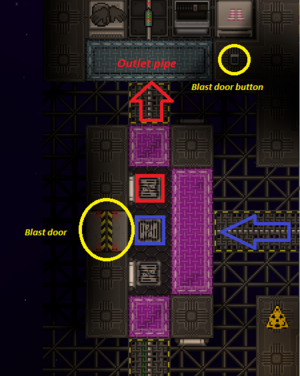Setting up the mix chamber: Difference between revisions
No edit summary |
|||
| Line 10: | Line 10: | ||
==Locating the mix chamber== | ==Locating the mix chamber== | ||
[[File:Mix chamber 2.png|thumb|An example of a mix chamber]] | |||
By default most pumps and pipes leading up to the mix chamber are toggled off at round start. Look around atmosia and locate the gas mixers by the different gas holding tanks. Follow the gas mixers outlet pipes until they all combine and terminate into a pump or manual valve that leads out of the station's hull. Look through the window and observe if the pumps lead into a nearby empty chamber containing both inlet and outlet passive vents and a blast door. If you found this, congratulations! you have located your mix chamber! Some stations, usually the small ones, are not equipped with a mix chamber. If the pipes lead to a vent in open space and you do not see a nearby empty chamber then there is mostly likely no mix chamber. Feel free to contact the head of your department and Centcom and complain about station budget cuts! | By default most pumps and pipes leading up to the mix chamber are toggled off at round start. Look around atmosia and locate the gas mixers by the different gas holding tanks. Follow the gas mixers outlet pipes until they all combine and terminate into a pump or manual valve that leads out of the station's hull. Look through the window and observe if the pumps lead into a nearby empty chamber containing both inlet and outlet passive vents and a blast door. If you found this, congratulations! you have located your mix chamber! Some stations, usually the small ones, are not equipped with a mix chamber. If the pipes lead to a vent in open space and you do not see a nearby empty chamber then there is mostly likely no mix chamber. Feel free to contact the head of your department and Centcom and complain about station budget cuts! | ||
Revision as of 19:56, 18 May 2022
So you are ready to graduate from Station Engineer up to Atmospherics Technician and are looking for something a little more in-depth than laying down wires and clicking on boxes to set up the AME? Well look no further, after reading this you will be smarter than those dummies next door and have the skills to show for it! This guide is designed to walk you through, step by step, in creating your first burn mix using the mix chamber. At the end you should have a basic understanding on how the burn chamber functions and if everything is done right you will be one step closer to mastering atmospherics!
Make sure you have a basic understanding on how atmospherics works. If you don't, read the guide to atmos and once you feel comfortable come back here.
About the mix chamber
As of right now, the mix chamber has almost no practical use. aside from creating awesome fire and cool looking gases It provides no power and no benefit to the station. It is just here for adventurous atmosians to flex their knowledge and to get a better understanding on how gases interact with one another at different ratios under various pressures and temperatures.
First things first
So you just started a new round on space station 14 and want to use the mix chamber. The very first things you should do is grab your equipment. Make sure you have either your firesuit or atmospheric hard suit and internals available to provide you some protection in case of an accident. Next, be sure to grab your handy dandy gas analyzer to be able to see what's going on inside those pipes. Lastly and arguably the most important thing you should do at round start is to consult with your fellow atmospheric technicians and Chief Engineer to make sure everyone is on the same page. The last thing you want to happen is to have your coworker unwittily dump your burn mix into the room by un-wrenching a pipe or find out that they accidently pumped your burning hot mix into distro.
Locating the mix chamber

By default most pumps and pipes leading up to the mix chamber are toggled off at round start. Look around atmosia and locate the gas mixers by the different gas holding tanks. Follow the gas mixers outlet pipes until they all combine and terminate into a pump or manual valve that leads out of the station's hull. Look through the window and observe if the pumps lead into a nearby empty chamber containing both inlet and outlet passive vents and a blast door. If you found this, congratulations! you have located your mix chamber! Some stations, usually the small ones, are not equipped with a mix chamber. If the pipes lead to a vent in open space and you do not see a nearby empty chamber then there is mostly likely no mix chamber. Feel free to contact the head of your department and Centcom and complain about station budget cuts!
